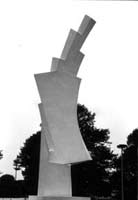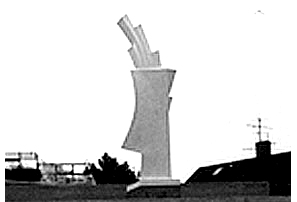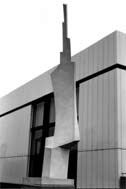


Reproduction photos
"The large MERZ Column"
The "large MERZ Column" was photographed by
Kurt Schwitters with his Rolleiflex at f:75mm; three photos showed the
column viewed from three sides.
Peter Bissegger travelled twice to Hjertoy to measure the houses that
can be made out from the original photographs and the distances between
them, so as to determine the camera position.
Thus the preconditions for a precise reconstruction were given.
The rest was a matter of applied geometry and its translation into three dimensions...
The "large MERZ Column" was made in a barn (on the right in the central photograph), near the small hut which Kurt Schwitters had already rented when he was still in Hanover, and to which he and his son Ernst fled when it became too dangerous for them to remain in their lodgings in Lysaker, near Oslo.
The sculpture was only placed outside for the purpose of photography:
the chief of police in Molde, hostile to Schwitters as a German, would never have agreed to the work being on display in the open. Besides, consisting as it did of wood and plaster, it would have become 'ver(sch)wittert' (weathered [Schwittered] to bits) in no time.
That is why various surviving eye-witnesses no longer remember this sculpture...
As in the reconstruction of
the MERZ Building, Peter Bissegger attempted to retrace as far as possible
the working methods of Kurt Schwitters.
To reconstruct the upper curved section of the "large MERZ Column",
Peter Bissegger
bent wooden boards into a norm-shape statically equivalent to the swung
form of a ship's hull, using the laws of physics to approach the original
form as closely as possible.
Incidentally, Kurt Schwitters constructed this part of the "large MERZ Column" either directly out of plastered ship's planks or (as the extreme slenderness of this part of the sculpture suggests) he made a "negative form" of a ship using wet plaster (and cloth or mesh?), then mounted this element with a post onto a wooden case (whose upper surface was slightly indented by the weight).
Dimensions of the reconstruction: O.60m x 3.07m x 0.97m
How did this sculpture get lost?
Schwitters had to leave the "large MERZ Column" behind in the barn, along with other sculptures, at the time of his escape from Molde; all of them were later destroyed by German occupation forces and Norwegian officials as examples of "degenerate art".